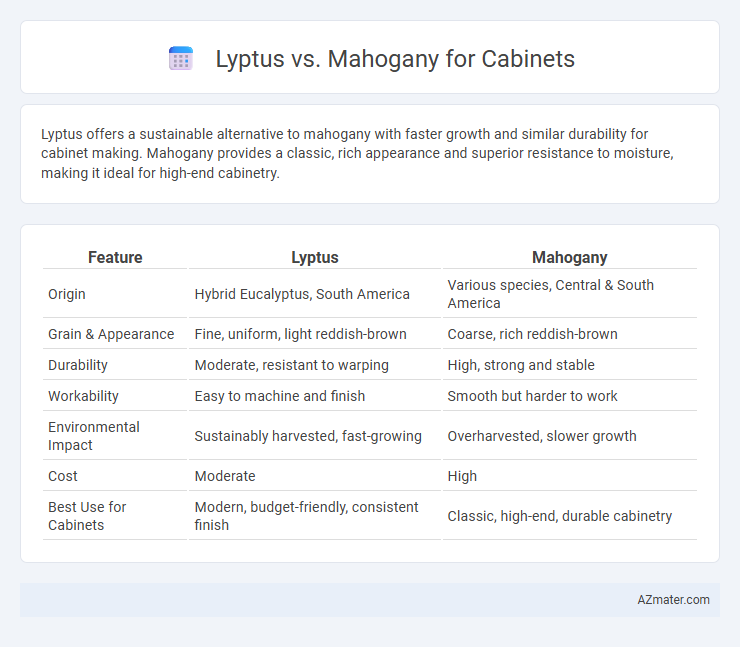Lyptus offers a sustainable alternative to mahogany with faster growth and similar durability for cabinet making. Mahogany provides a classic, rich appearance and superior resistance to moisture, making it ideal for high-end cabinetry.
Table of Comparison
| Feature | Lyptus | Mahogany |
|---|---|---|
| Origin | Hybrid Eucalyptus, South America | Various species, Central & South America |
| Grain & Appearance | Fine, uniform, light reddish-brown | Coarse, rich reddish-brown |
| Durability | Moderate, resistant to warping | High, strong and stable |
| Workability | Easy to machine and finish | Smooth but harder to work |
| Environmental Impact | Sustainably harvested, fast-growing | Overharvested, slower growth |
| Cost | Moderate | High |
| Best Use for Cabinets | Modern, budget-friendly, consistent finish | Classic, high-end, durable cabinetry |
Introduction to Lyptus and Mahogany
Lyptus is a fast-growing hybrid eucalyptus known for its dense grain, durability, and sustainable harvesting, making it an eco-friendly option for cabinetry. Mahogany, a traditional hardwood prized for its rich, warm tones and fine, straight grain, offers superior strength and natural resistance to decay. Both woods deliver excellent cabinet performance, but Lyptus stands out for its rapid renewability while Mahogany remains favored for luxury and classic appeal.
Wood Origin and Sustainability
Lyptus wood originates from fast-growing Eucalyptus trees cultivated primarily in managed plantations in South America, ensuring a renewable supply and minimizing deforestation. Mahogany is traditionally sourced from tropical rainforests in Central and South America, where overharvesting has led to reduced availability and increased environmental concerns. The sustainable management of Lyptus plantations contrasts with the often limited regulation surrounding mahogany harvesting, making Lyptus a more eco-friendly choice for cabinetry.
Appearance and Grain Patterns
Lyptus offers a consistent, fine grain with a pale, reddish hue that deepens over time, providing a uniform and modern aesthetic for cabinets. Mahogany features a richer, deeper reddish-brown color with more pronounced, swirling grain patterns that add a traditional, luxurious look. Both woods bring distinct visual textures, making Lyptus ideal for sleek, contemporary designs while Mahogany suits classic, elegant cabinetry.
Durability and Hardness Comparison
Lyptus wood exhibits exceptional durability and hardness, often ranking higher on the Janka hardness scale compared to traditional mahogany, making it highly resistant to dents and scratches for cabinetry. Mahogany, while known for its rich color and fine grain, offers moderate hardness, typically around 800 to 900 on the Janka scale, which is softer than the 1500+ rating commonly found in Lyptus. For cabinets requiring superior wear resistance and long-term durability, Lyptus provides a more robust option with enhanced performance against everyday impacts.
Workability and Ease of Cabinet Construction
Lyptus offers excellent workability with its fine, uniform texture and consistent grain, making it easy to cut, shape, and sand without splintering. Mahogany, known for its smooth grain and medium hardness, provides exceptional ease in cabinet construction, allowing for precise joinery and a high-quality finish. Both woods perform well, but Lyptus may reduce tool wear and speed up production due to its uniform density.
Cost Analysis: Lyptus vs Mahogany
Lyptus offers a more budget-friendly option compared to mahogany, with prices typically ranging from $4 to $8 per board foot versus mahogany's $10 to $25 per board foot. The lower cost of Lyptus is due to its faster growth rate and sustainable plantation sourcing, making it an economical choice for cabinetry. Mahogany's higher price reflects its luxury status, natural durability, and rich grain patterns, which appeal to high-end custom cabinetry markets.
Environmental Impact and Certification
Lyptus, a hybrid eucalyptus species, grows rapidly and is harvested from sustainably managed plantations certified by the Forest Stewardship Council (FSC), making it a low-impact choice for cabinet production. Mahogany, often harvested from tropical hardwood forests, faces deforestation concerns, but FSC-certified mahogany ensures responsible sourcing and reduced environmental harm. Choosing FSC-certified Lyptus or mahogany supports sustainable forestry practices and helps mitigate ecological damage associated with cabinet materials.
Finishing Qualities and Stain Absorption
Lyptus wood offers exceptional finishing qualities with a smooth surface that readily accepts stains, resulting in a uniform and vibrant color ideal for cabinetry. Mahogany, prized for its natural oils and fine grain, provides superior stain absorption that enhances its rich, deep hues while minimizing blotchiness. Both woods deliver durable finishes, but Lyptus tends to produce a more consistent color, whereas mahogany's stain absorption highlights its characteristic warmth and depth.
Maintenance and Longevity
Lyptus offers superior resistance to moisture and insects, reducing maintenance frequency compared to mahogany, which requires regular sealing to prevent damage. Its dense grain structure enhances durability, making cabinets less prone to scratches and warping over time. Mahogany, while aesthetically rich, demands more upkeep to retain its finish and structural integrity in high-humidity environments.
Best Applications and Recommended Uses
Lyptus wood, a hybrid of Eucalyptus species, offers exceptional hardness and resistance to wear, making it ideal for high-traffic cabinet surfaces and modern kitchen cabinetry where durability is crucial. Mahogany, prized for its rich, deep reddish-brown color and smooth grain, excels in luxury cabinetry and traditional furniture, providing a warm, elegant finish suitable for formal dining rooms and custom woodwork. Both woods perform well for cabinetry, with Lyptus favored in environments demanding sustainability and robustness, while Mahogany is recommended where aesthetic appeal and classic style are prioritized.

Infographic: Lyptus vs Mahogany for Cabinet
 azmater.com
azmater.com